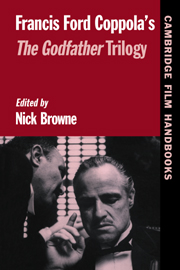Book contents
- Frontmatter
- Contents
- Acknowledgments
- List of Contributors
- Francis Ford Coppola's Godfather Trilogy
- Fearful A-Symmetries
- 1 If History Has Taught Us Anything … Francis Coppola, Paramount Studios, and The Godfather Parts I, II, and III
- 2 The Godfather and the Mythology of Mafia
- 3 The Representation of Ethnicity in The Godfather
- 4 Ideology and Genre in the Godfather Films
- 5 Family Ceremonies: or, Opera in The Godfather Trilogy
- Filmography
- Reviews of the “Godfather” Trilogy
- Select Bibliography
- Index
Fearful A-Symmetries
Violence as History in the Godfather Films
Published online by Cambridge University Press: 05 June 2012
- Frontmatter
- Contents
- Acknowledgments
- List of Contributors
- Francis Ford Coppola's Godfather Trilogy
- Fearful A-Symmetries
- 1 If History Has Taught Us Anything … Francis Coppola, Paramount Studios, and The Godfather Parts I, II, and III
- 2 The Godfather and the Mythology of Mafia
- 3 The Representation of Ethnicity in The Godfather
- 4 Ideology and Genre in the Godfather Films
- 5 Family Ceremonies: or, Opera in The Godfather Trilogy
- Filmography
- Reviews of the “Godfather” Trilogy
- Select Bibliography
- Index
Summary
By almost any account, the Godfather films are monuments on the landscape of American cinema. There are, of course, differences of intention and achievement among the three, but the first one, The Godfather (1972), stands out in popular and critical opinion as one of the enduring works of the American cinema. The standing of The Godfather Part II (1974), nearly comparable to the first, lies not only in its art, but in its outlook, so rare in American films from early 1970s, on a flawed American protagonist as an emblem of American empire. The Godfather Part III brings out the theme of redemption present in Coppola's vision from the start. It is natural to regard these films as a trilogy to deal with the continuity of a directorial vision of the century-long working through of economic crime and punishment in the inner sanctum of an American dynasty.
As a commercial venture, The Godfather and, to a lesser extent, The Godfather Part II were blockbusters. In its day, The Godfather was one of the most profitable films of all time. Over the years, it is said, the trilogy did business of more than a billion dollars. The Godfather continues to be loved by the public and remains one of the few enduring, still popular classics of American cinema. The films were breakout, critical successes as well, earning more than two dozen Academy Award nominations among them.
- Type
- Chapter
- Information
- Francis Ford Coppola's The Godfather Trilogy , pp. 1 - 22Publisher: Cambridge University PressPrint publication year: 1999
- 1
- Cited by

